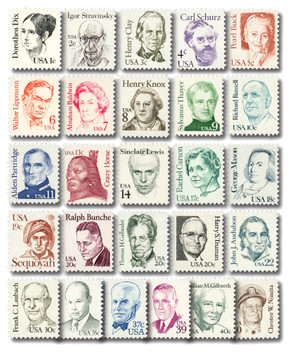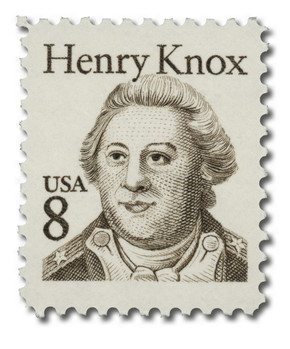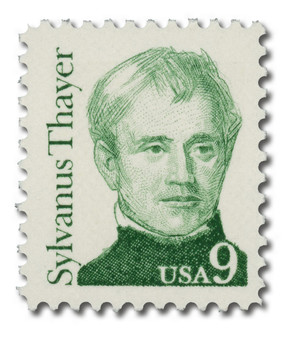
U.S. #1857
1981 17¢ Rachel Carson
Great Americans
- 3rd stamp in Great Americans Series
- Issued one day after Carson’s 74th birthday
- Features Carson’s favorite portrait of herself
Stamp Category: Definitive
Series: Great Americans
Value: 17¢; first-class rate for second ounce
First Day of Issue: May 28, 1981
First Day City: Springdale, Pennsylvania
Printed by: Bureau of Engraving & Printing
Printing Method: Engraved
Format: Panes of 100
Perforations: 11 x 10.5
Color: Green
Why the stamp was issued: To meet the new 17¢ rate on the second ounce of first-class mail.
About the stamp design: Ward Brackett designed this stamp, based on a photo by Erich Hartmann. The portrait, a left profile of Carson, had been her favorite.
First Day City: The First Day ceremony for this stamp was held at the Borough of Springdale Hall in Springdale, Pennsylvania, Carson’s hometown.
About the Great Americans Series: The Great Americans Series was created to replace the Americana Series. The new series would be characterized by a standard definitive size, simple design, and monochromatic colors.
This simple design included a portrait, “USA,” the denomination, the person’s name, and in some cases, their occupation or reason for recognition. The first stamp in the new series was issued on December 27, 1980. It honored Sequoyah and fulfilled the new international postcard rate that would go into effect in January 1981.
The Great Americans Series would honor a wider range of people than the previous Prominent Americans and Liberty Series. While those series mainly honored presidents and politicians, the Great Americans Series featured people from many fields and ethnicities. They were individuals who were leaders in education, the military, literature, the arts, and human and civil rights. Plus, while the previous series only honored a few women, the Great Americans featured 15 women. This was also the first definitive series to honor Native Americans, with five stamps.
The Bureau of Engraving and Printing (BEP) produced most of the stamps, but private firms printed some. Several stamps saw multiple printings. The result was many different varieties, with tagging being the key to understanding them. Though there were also differences in perforations, gum, paper, and ink color.
The final stamp in the series was issued on July 17, 1999, honoring Justin S. Morrill. Spanning 20 years, the Great Americans was the longest-running US definitive series. It was also the largest series of face-different stamps, with a total of 63.
Click here for all the individual stamps and click here for the complete series.
History the stamp represents: A naturalist, biologist, and zoologist, Rachel Carson devoted her studies to making people aware of pollutants, acid rain, and dangerous herbicides and pesticides. She argued that instead of saving our natural wealth, we were destroying it.
On September 27, 1962, Rachel Carson published the book Silent Spring, which inspired a massive environmental movement in the United States.
Rachel Carson, the “mother of the modern environmental movement” was born on May 27, 1907, in Springdale, Pennsylvania. After graduating from the Pennsylvania College for Women, she worked for the US Fish and Wildlife Service. There she wrote for radio and various publications.
As a marine biologist in the 1940s, Carson became aware of pesticides developed through government funds. After years of research, she became concerned with their effects on the environment. She left her job in 1952 to devote herself to writing.
On September 27, 1962, Carson published her most famous book, Silent Spring, about the harmful effects of pesticides. Silent Spring called attention to the overuse and misuse of pesticides, which were poisoning the food chain, and threatening life itself. Her work received strong opposition from the companies who manufactured the pesticides, but in time her thorough research resulted in winning over public opinion.
The following year, Carson appeared before President Kennedy’s Science Advisory Committee, which agreed with her findings on the dangers of pesticides. The same year, she received the Audubon Medal, the Cullum Medal (from the American Geographical Society), and was inducted into the American Academy of Arts and Letters.
Silent Spring and Carson’s other writings helped begin the environmental movement in America. This led to the creation of the Environmental Protection Agency and the eventual ban of the pesticide DDT. Decades later, Silent Spring was named one of the 25 greatest science books of all time.
U.S. #1857
1981 17¢ Rachel Carson
Great Americans
- 3rd stamp in Great Americans Series
- Issued one day after Carson’s 74th birthday
- Features Carson’s favorite portrait of herself
Stamp Category: Definitive
Series: Great Americans
Value: 17¢; first-class rate for second ounce
First Day of Issue: May 28, 1981
First Day City: Springdale, Pennsylvania
Printed by: Bureau of Engraving & Printing
Printing Method: Engraved
Format: Panes of 100
Perforations: 11 x 10.5
Color: Green
Why the stamp was issued: To meet the new 17¢ rate on the second ounce of first-class mail.
About the stamp design: Ward Brackett designed this stamp, based on a photo by Erich Hartmann. The portrait, a left profile of Carson, had been her favorite.
First Day City: The First Day ceremony for this stamp was held at the Borough of Springdale Hall in Springdale, Pennsylvania, Carson’s hometown.
About the Great Americans Series: The Great Americans Series was created to replace the Americana Series. The new series would be characterized by a standard definitive size, simple design, and monochromatic colors.
This simple design included a portrait, “USA,” the denomination, the person’s name, and in some cases, their occupation or reason for recognition. The first stamp in the new series was issued on December 27, 1980. It honored Sequoyah and fulfilled the new international postcard rate that would go into effect in January 1981.
The Great Americans Series would honor a wider range of people than the previous Prominent Americans and Liberty Series. While those series mainly honored presidents and politicians, the Great Americans Series featured people from many fields and ethnicities. They were individuals who were leaders in education, the military, literature, the arts, and human and civil rights. Plus, while the previous series only honored a few women, the Great Americans featured 15 women. This was also the first definitive series to honor Native Americans, with five stamps.
The Bureau of Engraving and Printing (BEP) produced most of the stamps, but private firms printed some. Several stamps saw multiple printings. The result was many different varieties, with tagging being the key to understanding them. Though there were also differences in perforations, gum, paper, and ink color.
The final stamp in the series was issued on July 17, 1999, honoring Justin S. Morrill. Spanning 20 years, the Great Americans was the longest-running US definitive series. It was also the largest series of face-different stamps, with a total of 63.
Click here for all the individual stamps and click here for the complete series.
History the stamp represents: A naturalist, biologist, and zoologist, Rachel Carson devoted her studies to making people aware of pollutants, acid rain, and dangerous herbicides and pesticides. She argued that instead of saving our natural wealth, we were destroying it.
On September 27, 1962, Rachel Carson published the book Silent Spring, which inspired a massive environmental movement in the United States.
Rachel Carson, the “mother of the modern environmental movement” was born on May 27, 1907, in Springdale, Pennsylvania. After graduating from the Pennsylvania College for Women, she worked for the US Fish and Wildlife Service. There she wrote for radio and various publications.
As a marine biologist in the 1940s, Carson became aware of pesticides developed through government funds. After years of research, she became concerned with their effects on the environment. She left her job in 1952 to devote herself to writing.
On September 27, 1962, Carson published her most famous book, Silent Spring, about the harmful effects of pesticides. Silent Spring called attention to the overuse and misuse of pesticides, which were poisoning the food chain, and threatening life itself. Her work received strong opposition from the companies who manufactured the pesticides, but in time her thorough research resulted in winning over public opinion.
The following year, Carson appeared before President Kennedy’s Science Advisory Committee, which agreed with her findings on the dangers of pesticides. The same year, she received the Audubon Medal, the Cullum Medal (from the American Geographical Society), and was inducted into the American Academy of Arts and Letters.
Silent Spring and Carson’s other writings helped begin the environmental movement in America. This led to the creation of the Environmental Protection Agency and the eventual ban of the pesticide DDT. Decades later, Silent Spring was named one of the 25 greatest science books of all time.















